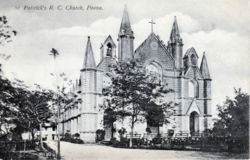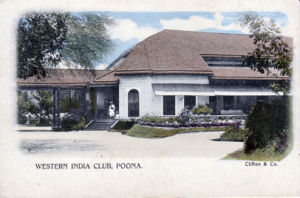Poona
| Poona | |
|---|---|

| |
| Presidency: Bombay | |
| Coordinates: | 18.520469°N, 73.85662°E |
| Altitude: | 560 m (1,837 ft) |
| Present Day Details | |
| Place Name: | Pune |
| State/Province: | Maharashtra |
| Country: | India |
| Transport links | |
| Great Indian Peninsula Railway Southern Mahratta Railway | |
Poona is a city about 100km south-east of Bombay (now Mumbai), which was formerly a garrison town of the British Army. In recent times it has been famous for being the birthplace of the British comedian Spike Milligan, and the ashram of the Orange People (followers of Sri Rajneesh).
Poona was an important junction where the metre gauge Southern Mahratta Railway met the broad gauge of the Great Indian Peninsula Railway.
Contents
History
Poona grew under the Moguls from 1636 as a trade route. Its importance escalated after 1750 when it became the capital of the Marathá Empire. Under the British, the railways opened up communication routes to Bombay which had been constrained by the terrain.
Battle of Poona 1817
Spelling Variants
Modern name: Pune
Variants: Poona
Education
Further Education
Poona Sanskrit College 1837 opened and offered a combined Sanskrit and medicine course (linked to Sansoon General Hospital) – under Superintendant: Captain Candy.
Sanskrit and Vernacular College est 1851/52, formed from the amalgamation of Poona’s English and Venacular schools, later it became the Deccan Arts College 1857, with an affiliation to Bombay University 1860.
The Engineering College was founded 1865 and was affiliated to Bombay University (its creation is contemporary with the construction of the Great Indian Peninsular Railway) Later (1880) it was known as the College for Science . It educated staff for the Public Works Department. Courses were offered in: Civil Engineering, Agriculture, Forestry, plus apprentice training.
Schools
Supplementing native sanskrit schools, Government Schools opened in 1826 to teach vernacular, initially under control of Mr Jervis. Numbers increased to 3 Government Schools in Poona by 1847, and 23 by 1883 (many other existed in the greater Poona district). They comprised:
- High School 1
- Anglo-Vernacular 2
- Vernacular 18
- Teacher Training schools 2 (male est: 1857, female est: 1870)
In addition there were 45 Private schools, including:
- Bishops High School, est1864,
- St Vincent Roman Catholic High School est 1867 includes anglo-indian section,
- Free Church Mission Institute est 1866
- Poona Native Institution est 1866
- The Pensioner's Middle Class School for boys and girls est 1864
- The Conference Middle Class School est 1879
- The Mission Orphanage and Christian Boys Middle Class School est 1879
- The Victoria Girls High School est 1876
- St Mary’s Girls High School est 1867
- The Convent High School for Girls est 1860
- The Scottish Girls High School est 1882
- St Anne’s Middle Class School for Girls est 1873
- The Zanana Mission Anglo-Vernacular School for Girls est 1882 in Sukravar Peth, Sadasiv Peth *Civil Lines and Kamathipura
- The Free Church Mission School for Boys est 1876 in Aditvar Peth
- The Mission Orphanage Panch Haud Vernacular School est 1882
- The Free Church Mission School for Girls est 1850 in the camp
- The Free Church Mission for Girls Vernacular School est 1882 in Aditvar Peth
- The Bene-Israel Girls Vernacular School in Rastya Peth est 1882
- The New English School est 1880
Hospitals
In addition to the Sansoon General Hospital, Roman Catholic Orphanage, Charitable Infirmary, and Leper Hospital,there were 10 dispenseries in Poona.
Newspapers
European newspapers were the Deccan Herald, and Poona Observer.
External links
Historical Books Online
Gazetteer of the Bombay Presidency Archive.org
Other
- "Poona" LoveToKnow 1911
- "Pune" Wikipedia
- Deccan Queen: A Spatial Analysis of Poona in the Nineteenth and Early Twentieth Centuries by Wayne Thomas Mullen. Sydney University Digital Theses 26 March 2006. A thesis which is “structured around the analysis of a model that describes the Cantonment, the Civil Lines, the Sadr Bazar and part of the Native City of the Western Indian settlement of Poona in the late nineteenth and early twentieth centuries”
